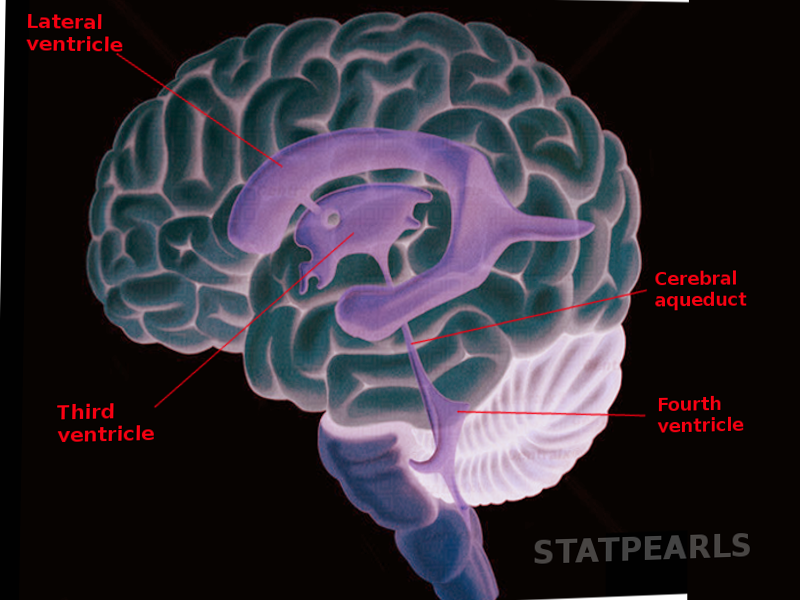[1]
Mortazavi MM, Adeeb N, Griessenauer CJ, Sheikh H, Shahidi S, Tubbs RI, Tubbs RS. The ventricular system of the brain: a comprehensive review of its history, anatomy, histology, embryology, and surgical considerations. Child's nervous system : ChNS : official journal of the International Society for Pediatric Neurosurgery. 2014 Jan:30(1):19-35. doi: 10.1007/s00381-013-2321-3. Epub 2013 Nov 16
[PubMed PMID: 24240520]
[2]
Jellinger G. Anatomopathology of non-tumoral aqueductal stenosis. Journal of neurosurgical sciences. 1986 Jan-Jun:30(1-2):1-16
[PubMed PMID: 3772492]
[3]
Longatti P, Fiorindi A, Perin A, Martinuzzi A. Endoscopic anatomy of the cerebral aqueduct. Neurosurgery. 2007 Sep:61(3 Suppl):1-5; discussion 5-6
[PubMed PMID: 17876227]
[4]
Longatti P, Fiorindi A, Feletti A, D'Avella D, Martinuzzi A. Endoscopic anatomy of the fourth ventricle. Journal of neurosurgery. 2008 Sep:109(3):530-5. doi: 10.3171/JNS/2008/109/9/0530. Epub
[PubMed PMID: 18759587]
[5]
Lee JH, Lee HK, Kim JK, Kim HJ, Park JK, Choi CG. CSF flow quantification of the cerebral aqueduct in normal volunteers using phase contrast cine MR imaging. Korean journal of radiology. 2004 Apr-Jun:5(2):81-6
[PubMed PMID: 15235231]
[6]
Tisell M, Almström O, Stephensen H, Tullberg M, Wikkelsö C. How effective is endoscopic third ventriculostomy in treating adult hydrocephalus caused by primary aqueductal stenosis? Neurosurgery. 2000 Jan:46(1):104-10; discussion 110-1
[PubMed PMID: 10626941]
[7]
Schmid Daners M, Knobloch V, Soellinger M, Boesiger P, Seifert B, Guzzella L, Kurtcuoglu V. Age-specific characteristics and coupling of cerebral arterial inflow and cerebrospinal fluid dynamics. PloS one. 2012:7(5):e37502. doi: 10.1371/journal.pone.0037502. Epub 2012 May 30
[PubMed PMID: 22666360]
[8]
Deopujari CE, Karmarkar VS, Shaikh ST. Endoscopic Third Ventriculostomy: Success and Failure. Journal of Korean Neurosurgical Society. 2017 May:60(3):306-314. doi: 10.3340/jkns.2017.0202.013. Epub 2017 May 1
[PubMed PMID: 28490157]
[9]
Kaur LP, Munyiri NJ, Dismus WV. Clinical analysis of aqueductal stenosis in patients with hydrocephalus in a Kenyan setting. The Pan African medical journal. 2017:26():106. doi: 10.11604/pamj.2017.26.106.11050. Epub 2017 Feb 28
[PubMed PMID: 28533829]
[10]
Fukuhara T, Luciano MG. Clinical features of late-onset idiopathic aqueductal stenosis. Surgical neurology. 2001 Mar:55(3):132-6; discussion 136-7
[PubMed PMID: 11311904]
[11]
BICKERS DS, ADAMS RD. Hereditary stenosis of the aqueduct of Sylvius as a cause of congenital hydrocephalus. Brain : a journal of neurology. 1949 Jun:72(Pt. 2):246-62
[PubMed PMID: 18136715]
[12]
WARREN MC, LU AT, ZIERING WH. SEX-LINKED HYDROCEPHALUS WITH AQUEDUCTAL STENOSIS. The Journal of pediatrics. 1963 Dec:63():1104-10
[PubMed PMID: 14089815]
[13]
Feletti A, Fiorindi A, Longatti P. Split cerebral aqueduct: a neuroendoscopic illustration. Child's nervous system : ChNS : official journal of the International Society for Pediatric Neurosurgery. 2016 Jan:32(1):199-203. doi: 10.1007/s00381-015-2827-y. Epub 2015 Aug 1
[PubMed PMID: 26231565]
[14]
Johnson RT, Johnson KP. Hydrocephalus as a sequela of experimental myxovirus infections. Experimental and molecular pathology. 1969 Feb:10(1):68-80
[PubMed PMID: 4303572]
[15]
Solá J, Arcas I, Martínez-Lage JF, Martínez Pérez M, Esteban JA, Poza M. Astrocytoma of the cerebral aqueduct. Child's nervous system : ChNS : official journal of the International Society for Pediatric Neurosurgery. 1987:3(5):294-6
[PubMed PMID: 3427574]
[16]
Igboechi C, Vaddiparti A, Sorenson EP, Rozzelle CJ, Tubbs RS, Loukas M. Tectal plate gliomas: a review. Child's nervous system : ChNS : official journal of the International Society for Pediatric Neurosurgery. 2013 Oct:29(10):1827-33. doi: 10.1007/s00381-013-2110-z. Epub 2013 Apr 24
[PubMed PMID: 23612874]
[17]
Rousselle C, des Portes V, Berlier P, Mottolese C. Pineal region tumors: Clinical symptoms and syndromes. Neuro-Chirurgie. 2015 Apr-Jun:61(2-3):106-12. doi: 10.1016/j.neuchi.2013.08.009. Epub 2014 Jan 17
[PubMed PMID: 24439798]
[18]
Recinos PF, Rahmathulla G, Pearl M, Recinos VR, Jallo GI, Gailloud P, Ahn ES. Vein of Galen malformations: epidemiology, clinical presentations, management. Neurosurgery clinics of North America. 2012 Jan:23(1):165-77. doi: 10.1016/j.nec.2011.09.006. Epub
[PubMed PMID: 22107867]

